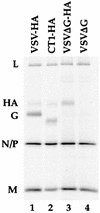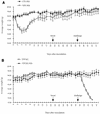Attenuated vesicular stomatitis viruses as vaccine vectors
- PMID: 10196265
- PMCID: PMC104148
- DOI: 10.1128/JVI.73.5.3723-3732.1999
Attenuated vesicular stomatitis viruses as vaccine vectors
Abstract
We showed previously that a single intranasal vaccination of mice with a recombinant vesicular stomatitis virus (VSV) expressing an influenza virus hemagglutinin (HA) protein provided complete protection from lethal challenge with influenza virus (A. Roberts, E. Kretzschmar, A. S. Perkins, J. Forman, R. Price, L. Buonocore, Y. Kawaoka, and J. K. Rose, J. Virol. 72:4704-4711, 1998). Because some pathogenesis was associated with the vector itself, in the present study we generated new VSV vectors expressing HA which are completely attenuated for pathogenesis in the mouse model. The first vector has a truncation of the cytoplasmic domain of the VSV G protein and expresses influenza virus HA (CT1-HA). This nonpathogenic vector provides complete protection from lethal influenza virus challenge after intranasal administration. A second vector with VSV G deleted and expressing HA (DeltaG-HA) is also protective and nonpathogenic and has the advantage of not inducing neutralizing antibodies to the vector itself.
Figures





Similar articles
-
A viable recombinant rhabdovirus lacking its glycoprotein gene and expressing influenza virus hemagglutinin and neuraminidase is a potent influenza vaccine.J Virol. 2015 Mar;89(5):2820-30. doi: 10.1128/JVI.03246-14. Epub 2014 Dec 24. J Virol. 2015. PMID: 25540378 Free PMC article.
-
Vaccination with a recombinant vesicular stomatitis virus expressing an influenza virus hemagglutinin provides complete protection from influenza virus challenge.J Virol. 1998 Jun;72(6):4704-11. doi: 10.1128/JVI.72.6.4704-4711.1998. J Virol. 1998. PMID: 9573234 Free PMC article.
-
Vaccination with Vesicular Stomatitis Virus-Vectored Chimeric Hemagglutinins Protects Mice against Divergent Influenza Virus Challenge Strains.J Virol. 2015 Dec 16;90(5):2544-50. doi: 10.1128/JVI.02598-15. J Virol. 2015. PMID: 26676789 Free PMC article.
-
Intramuscular immunization with a vesicular stomatitis virus recombinant expressing the influenza hemagglutinin provides post-exposure protection against lethal influenza challenge.Vaccine. 2009 Dec 10;28(1):79-89. doi: 10.1016/j.vaccine.2009.09.112. Epub 2009 Oct 9. Vaccine. 2009. PMID: 19819211 Free PMC article.
-
Potent vesicular stomatitis virus-based avian influenza vaccines provide long-term sterilizing immunity against heterologous challenge.J Virol. 2010 May;84(9):4611-8. doi: 10.1128/JVI.02637-09. Epub 2010 Feb 24. J Virol. 2010. PMID: 20181720 Free PMC article.
Cited by
-
A chimeric vesiculo/alphavirus is an effective alphavirus vaccine.J Virol. 2013 Jan;87(1):395-402. doi: 10.1128/JVI.01860-12. Epub 2012 Oct 17. J Virol. 2013. PMID: 23077320 Free PMC article.
-
A viable recombinant rhabdovirus lacking its glycoprotein gene and expressing influenza virus hemagglutinin and neuraminidase is a potent influenza vaccine.J Virol. 2015 Mar;89(5):2820-30. doi: 10.1128/JVI.03246-14. Epub 2014 Dec 24. J Virol. 2015. PMID: 25540378 Free PMC article.
-
Recombinant vesicular stomatitis virus vaccine vectors expressing filovirus glycoproteins lack neurovirulence in nonhuman primates.PLoS Negl Trop Dis. 2012;6(3):e1567. doi: 10.1371/journal.pntd.0001567. Epub 2012 Mar 20. PLoS Negl Trop Dis. 2012. PMID: 22448291 Free PMC article.
-
Evaluation of attenuated VSVs with mutated M or/and G proteins as vaccine vectors.Vaccine. 2012 Feb 8;30(7):1313-21. doi: 10.1016/j.vaccine.2011.12.085. Epub 2012 Jan 2. Vaccine. 2012. PMID: 22222871 Free PMC article.
-
Glycoprotein exchange vectors based on vesicular stomatitis virus allow effective boosting and generation of neutralizing antibodies to a primary isolate of human immunodeficiency virus type 1.J Virol. 2000 Dec;74(23):10903-10. doi: 10.1128/jvi.74.23.10903-10910.2000. J Virol. 2000. PMID: 11069984 Free PMC article.
References
-
- Cline B L. Ecological associations of vesicular stomatitis virus in rural Central America and Panama. Am J Trop Med Hyg. 1976;25:875–883. - PubMed
-
- Dietzschold B, Rupprecht C E, Fu Z F, Koprowski H. Rhabdoviruses. In: Fields B N, Knipe D M, Howley P M, editors. Fields virology. 3rd ed. Vol. 1. Philadelphia, Pa: Lippincott-Raven; 1996. pp. 1137–1159.
-
- Eldadah A H, Nathanson N, Sarsitis R. Pathogenesis of West Nile Virus encephalitis in mice and rats. 1. Influence of age and species on mortality and infection. Am J Epidemiol. 1967;86:765–775. - PubMed
-
- Fellowes O N, Dimopoullos G T, Callis J J. Isolation of vesicular stomatitis virus from an infected laboratory worker. Am J Vet Res. 1955;16:623–626. - PubMed
Publication types
MeSH terms
Substances
Grants and funding
LinkOut - more resources
Full Text Sources
Other Literature Sources
Medical

